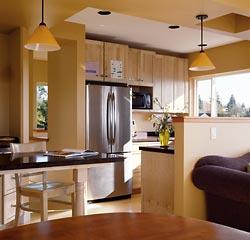Resource-Respectful By Design

"REBECCA WAS looking for a view, and I was looking for a project," says James Lucal.
And that's just what Lucal and his wife, Rebecca Romanelli, got in their new, three-story Craftsman on Phinney Ridge.
Sitting in the crow's nest of a great room up on the third floor, Romanelli scans the world from her new perspective. So much to see: the frosty-white Olympic Mountains, the blue-gray waters of the Ship Canal and Puget Sound, Ballard's swinging construction cranes, Magnolia's condo-caked hillside, boats bobbing at Fisherman's Terminal, the Ballard Bridge groaning open. She sighs, sated.
Lucal, however, is just taking a break. The project he sought, to build an energy-efficient house for his family while consuming as few resources as he could, is not quite finished. The attic, wearing half a bamboo floor, awaits.
"I like the process of starting with the raw land, and sustainability seems to be my new direction," he says. Romanelli calls her husband "a renaissance guy with a doctorate." In other words, it's a short hop from passing interest to passion.
Lucal was a mental-health counselor for 20 years and teaches occasionally at Western Washington University. He's also a musician, theater guy and a contractor. This project has led to a new contracting business he calls "Living Lightly."
Green dwellings first caught Lucal's attention years ago: He built their 600-square-foot cabin on Lopez Island in 1983 off the power grid (solar panels, wood stove, well water). That was only the beginning. Four years ago, the family moved from Broadview to a 1929 Phinney Ridge Tudor with an eye toward building their green city house: The property was available for subdividing. They would build their new green house behind the Tudor, then sell the old house. Lucal spent nights and weekends doing research — on the Internet, in books, with his solar designer.
Then, a major source of recycled lumber came their way when the two elderly sisters who lived next door could no longer remain in their home. They offered to sell Lucal and Romanelli their well-worn house. Lucal salvaged 500 board feet of the sisters' lumber. He recycled all the metal and more than 25 cubic yards of wood. Old 6-by-6-inch beams, sanded and refinished, have a new future as stair railings and trim. The new attic is paneled using the sisters' milled beams.
Free lumber already on site and serving as his own general contractor helped Lucal hold construction costs down. That and family labor. Lucal's brother-in-law was upstairs fitting bamboo floorboards even as we spoke.
"When somebody says green costs more, I say it doesn't have to," says their building and solar designer, Chris Herman.
Lucal, a member of the Northwest EcoBuilding Guild, was pleasantly surprised by the cooperation he received from the King Conservation District and the city of Seattle.
Despite its reputation for being difficult to deal with, the Seattle Planning Department "let us build the way we wanted to," he says, specifically recalling the height exemption granted for the solar panels.
Romanelli, a massage therapist, focused her attention on the home's healing aspects. She chose paints from Devine Color in Portland because they are low VOC (volatile organic chemicals) and promise to create "harmony without monotony and contrast without conflict." Recycled-glass accents on the terrace fence are from Bedrock Industries.
"I love color!" she says. Therefore, the exterior is a quiet lavender and interior walls inspire in pistachio, ale and oak.
So, would they do it again?
Romanelli plops her head into her folded arms on the kitchen table. "I would prefer not to," she says.
"Do I want to be consulted 24-7 on the size of sewer lines? Even our 9-year-old was grossed out by our dinner conversation. She would say, 'Can we talk about something other than the house?' "
But Lucal is smiling: "I have to build another house. When you take a house out in Seattle you have to replace it. We have plans for a garage with an apartment.
"My fantasy is to go greener. To scrounge more."
Rebecca Teagarden is assistant editor of Pacific Northwest magazine. Benjamin Benschneider is a magazine staff photographer.





Design: James Lucal; Chris Herman of Winter Sun consulted and refined drawings; Puget Sound Solar implemented photovoltaic and solar-electric-generating systems and solar water heating.
Cost: $480,000 ($100,000 of that site-related); about $115 per square foot.
Size: 3,200 square feet; 12 rooms, three floors.
Green features: Solar-heated water, photovoltaics, Marmoleum, Hardiplank siding, recycled lumber and rainwater, engineered wood (recycled/reconstituted wood products that are laminated or jointed) super insulation, high-efficiency appliances, gas heat with condensing boiler, drought-tolerant plants.